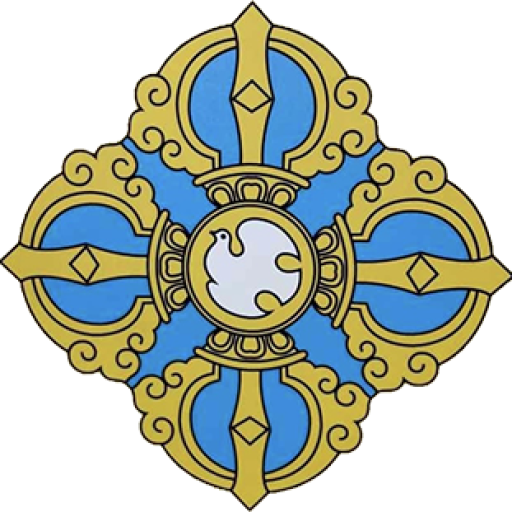Brief History
Brief history of the Five Principal Spiritual Traditions of Tibet
Courtesy – The Council for Religious and Cultural Affairs of His Holiness the Dalai Lama
Tradition has it that Tibet is the land of Avalokiteshvara, the bodhisattva of compassion. Tibetan people trace their ancestry to the copulation of an ape, an emanation of Avalokiteshvara, and an ogress, an emanation of the goddess Tara, whose progeny gave birth to the Tibetan people in the Yarlung valley.
In 127 B.C.E., according to legend an Indian king named Rupati fled over the Himalayas after his defeat in Mahabharata war and reached the Yarlung valley. There, he was enthroned as their king by twelve wise Bon priests, who, believing that he had descended from heaven gave him the name Nyatri Tsenpo. From this time, the Tibetans evolved a distinct but simple civilization founded on the idea of the interdependence of man and nature. In the pre-Buddhist period Tibet’s indigenous religion and culture was Bon, which, though radically transformed through its contact with Buddhism, is still preserved among Tibetan communities in exile. Buddhism became Tibet’s state religion only later. Introduced for the first time in 173 C.E., during the reign of King Lha Thothori Nyantsen, it was gradually assimilated, disseminated and finally integrated into the Tibetan way of life due initially to the efforts of the religious kings. King Song Tsen Gampo took control of the kingdom at the age of thirteen and built Rasa Trulnang Tsuglag Khang and Ramoche Tsuglag Khang two temples in Lhasa. He sent his minister Thonmi Sambhota to India to learn Sanskrit and writing, and as a result a Tibetan script was then modeled on one of those current in India. He invited Acharya Kumara and Brahmin Shankara from India and the Nepalese Acharya Shilmanju, who began the propagation and translation of the Buddha’s teachings. Although there was neither conspicuous nor extensive study of Buddhist doctrine, the king himself gave instructions to many fortunate people, mostly concerning the teachings of the Arya Avalokiteshvara.
During the reign of King Trisong Deutsen, Buddhism was spread with great zeal after he had invited the Abbot Shantarakshita and Acharya Padmasambhava to Tibet. The task of translating Buddha’s teachings was carried out with great vigor and enthusiasm. It is said that altogether one hundred and eight Indian scholars were engaged with Tibetan translators in the work of translating Buddhist literature into Tibetan. They also took part in establishing monasteries.
After three generations, the religious king Tri Ralpachen issued a decree that every monk should be supported by seven households. At the same time thousands of temples were constructed. He also invited many more Indian masters such as the Acharyas Jinamitra, Surendrabodhi and Danashila, who with the Tibetan translators Yeshede and others revised and standardized the earlier translations according to a revised terminology. In this way the Buddha’s teachings were increasingly being propagated throughout Tibet. Unfortunately, this golden period known as the era of the Tibet’s Religious Kings soon came to an end. Ralpachen’s successor, King Lang Dharma, did not support the Buddha’s teaching. Monasteries were emptied and the monks made to disrobe, often being recruited into the army. As the Tibetan empire disintegrated into small principalities, Tibetan Buddhist culture entered a dark period.
However, at that time Mar Shakya Yeshi, Yogejung and Tsang Rabsel, holders of the monastic lineage of the great Abbot Shantarakshita managed to escape to the Domey (north-eastern) region of Tibet, where with the help of two Chinese monks they gave full ordination to Lachen Gongpa Rabsel, which marked the revival of the Tibetan monastic community. Similarly, with the arrival of Sadhupala and others in upper Ngari (western Tibet), and coming of the great Kashmiri scholar Shakyashri the monastic lineages were greatly expanded and the community multiplied. Amongst those who were ordained by Gongpa Rabsel, Lumey and others returned to central Tibet and revived Buddhism there, building monasteries and temples and teaching the doctrine.
The most vigorous revival of Buddhism, however, was taking place in western Tibet where Lha Lama Yeshe Woe, following the ways of the early religious kings had dispatched intelligent young Tibetans to Kashmir, then a thriving centre of Buddhist learning. The great translator, Rinchen Zangpo (958-1055) and his colleague Legpai Sherab returned successfully to Tibet and spread the doctrine through translation, teaching and establishing monasteries. Lha Lama Yeshe Woe’s persistence and sacrifice also created the conditions for inviting the great Indian master Atisha to Tibet. He revived the doctrine and dispelled many misconceptions about it then current. He composed the famous text, A lamp on the path to Enlightenment which set the pattern for all the graded path, Lam-rim, texts found in the Tibetan Buddhist tradition.
Among Atisha’s many disciples, Drom Tonpa, who later consolidated Atisha’s teachings and found the Kadampa tradition, was the most famous. During this period, Tibet’s contact with the Indian Buddhist tradition was restored, and the influence of different masters led to a diversity of teaching lineages. Gradually three major new orders, Sakya, Kagyu and Gelug arose. Nyingma was identified as the form of Buddhism introduced since Guru Padmasambhava’s arrival in Tibet. These were the four great schools of Tibetan Buddhism, which will be introduced below.
With the growing influence of the Mongolians in Tibet, the so called priest-patron relationship was established between the Mongol rulers and Sakya Lamas of Tibet. Consequently, in 1253 Kublai Khan offered the three provinces of Tibet to the Sakya Lama Drogon Chogyal Phagpa, whose successors ruled Tibet for one hundred and five years until 1358 when they lost control of Tibet to Tai Situ Jamchub Gyeltsen. The subsequent rule of the Phagmotrupa lineage lasted until 1435 followed by the Rinpung Kings who ruled for four generations from 1435-1565 and the three Tsangpa kings 1566-1641.
By the turn of sixteenth century, the power and influence of the Gelugpa had grown enormously. The third Dalai Lama, Sonam Gyatso (1543-1588), strengthened Tibet’s political prospects when he brought the Mongols back to Buddhism. This resulted from his visit to Mongolia in 1578 at the invitation of Altan Khan of the Tümet Mongols, who also gave him the title ‘Dalai Lama’, meaning ‘Ocean of Wisdom’. The fourth Dalai Lama, Yonten Gyatso, was born to a Mongolian family, but was taken to Tibet to be educated. In 1642, Güshri Khan placed both the spiritual and temporal rule of Tibet in the hands of the great Fifth Dalai Lama, Ngawang Lobsang Gyatso (1617-1682). He founded the Ganden Phodrang government, which today continues to function under the leadership of the Fourteenth Dalai Lama.
There were more than 6000 monasteries and nunneries in the three regions of Tibet – U-Tsang, Doto and Domey. Of these hardly any were left undamaged and the majority were totally destroyed by the Chinese. In exile, more than 300 monasteries and nunneries have been re-established in India, Nepal and Bhutan. Around 800 Tibetan Buddhist centers are functioning as religious and cultural centers in various countries around the world.
The Bon Tradition
Tibet’s oldest spiritual tradition is Bon. According to Bonpo accounts, eighteen enlightened teachers will appear in this aeon and Tonpa Shenrab, the founder of the Bon religion, is the enlightened teacher of this age. He is said to have been born in the mythical land of Olmo Lung Ring, whose location remains something of a mystery. The land is traditionally described as dominated by Mount Yung-drung Gu-tzeg (Edifice of Nine Swastikas), which many identify as Mount Kailash in western Tibet. Due to the sacredness of Olmo Lung Ring and the mountain, both the counter-clockwise swastika and the number nine are of great significance in the Bon religion.
It is believed that Tonpa Shenrab first studied the Bon doctrine in heaven, at the end of which he pledged at the feet of the god of compassion, Shenla Okar, to guide the people of this world. Accordingly, at the age of thirty one he renounced the world and took up a life of austerity, spreading the doctrine in order to help the beings immersed in an ocean of misery and suffering. In his effort to spread the doctrine, he arrived in Tibet, in the region of Mount Kailash, which is known as the land of Zhang Zhung, historically the principal seat of Bon culture and doctrine. Accounts of Tonpa Shenrab’s life are to be found in three major sources: mDo-‘dus, gZer-mig and gZi-brjig. The first two are believed to be treasure texts (gTer-ma) discovered according to Bon history in the tenth or eleventh century. The third belongs to the whispered lineage (sNyan-brgyud) transmitted amongst adepts.
The doctrines taught by Tonpa Shenrab are generally classified into two types, first, The Four Portals and One Treasury (sGo-bzhi mDzod -lnga): the White Water (Chab-dkar) doctrine dealing with esotric matters; the Black Water (Chab-nag) doctrine concerning narratives, magic, funeral rites and ransom rituals; the Land of Phan (‘Phan-yul) doctrine which contains monastic rules and philosophical expositions; the Divine Guide (dPon-gsas) doctrine containing exclusively the great perfection teachings; and finally, the Treasury (mTho-thog) which comprises the essential aspects of all the four portals.
The second classification, the Nine way of Bon (Bon theg-pa rim-dga) is as follows: the Way of Prediction (Phyva-gshen theg-pa), which describes sortilege, astrology, ritual and prognostication; the Way of the Visual World (sNag-gshen theg-pa), which explains the psychophysical universe; the way of Illusion (‘Phrul-gshen theg-pa), Which gives details of the rites for the dispersing adverse forces; the Way of Existence (Srid-gshen theg-pa), which explains funeral and death rituals; the Way of a Lay which explains funeral and death rituals; the Way of a Lay Follower (dGe-bsnyen theg-pa), which contains the ten principles for wholesome activity; the Way of a Monk, (Drag-srong theg-pa), in which the monastic rules and regulations are laid out; the Way of Primordial Sound (A-dkar theg -pa), which explains the integration of an exalted practitioner into the mandala of highest enlightenment; the Way of Primordial Shen, (Ye-gshen theg-pa), which explains the guidelines for seeking a true tantric master and the spiritual commitment that binds a disciple to his tantric master; and finally, the Way of Supreme Doctrine (Bla-med theg -pa), which discusses only the doctrine of great perfection.
The nine ways are further synthesized into three: the first four as the Causal Ways (rGyu’i-theg-pa), the second four as the Resultant Ways (‘Bras-bu’i-theg-pa) and the ninth as the Unsurpassable way or the Way of Great Completion (Khyad-par chen po’i-theg-pa or rDzogs-chen). These are contained in the Bon canon comprising more than two hundred volumes classified under four sections: the sutras (mDo), the perfection of wisdom teachings (‘Bum), and the tantras (rGyud) and knowledge (mDzod). Besides these, the canon deals with other subjects such as rituals, arts and crafts, logic, medicine, poetry and narrative. It is interesting to note that the knowledge (mDzod) section concerning cosmology and cosmogony is quite unique to Bon, though there is scholarly speculation that it has a strong affinity with certain Nyingma doctrines.
History has it that with increasing royal patronage of Buddhism, Bon was discouraged, and faced persecution and banishment. Practically nothing is known about Bon during the period from the eighth to the early eleventh centuries. However, with the relentless devotion and Endeavour of sincere followers such as Drenpa Namkha (9th century(, Shenchen Kunga (10th century) and many others the Bon, Tibet’s indigenous religion, was rescued from oblivion and re-established itself alongside Buddhism in Tibet.
Since the eleventh century, with the founding of monasteries such as Yeru Ensakha, Kyikhar Rishing, Zangri and later Menri and Yungdrung Ling in Central Tibet; and Nangleg Gon, Khyunglung Ngulkar and others, more than three hundred Bon monasteries has been established in Tibet prior to Chinese occupation. Of these, Menri and Yungdrung monasteries were the major monastic universities for the study and practice of Bon doctrines. A reassessment of Bon took place in the nineteenth century at the hands of Sharza Tashi Gyeltsen, a Bon Master whose collected writings comprising eighteen volumes gave the tradition new impetus. His follower Kagya Khyngtrul Jigmey Namkha trained many disciples learned in not only the Bon religion, but in all the Tibetan sciences. However, with the Chinese invasion of Tibet, like the other spiritual traditions, Bon also faced irreparable loss.
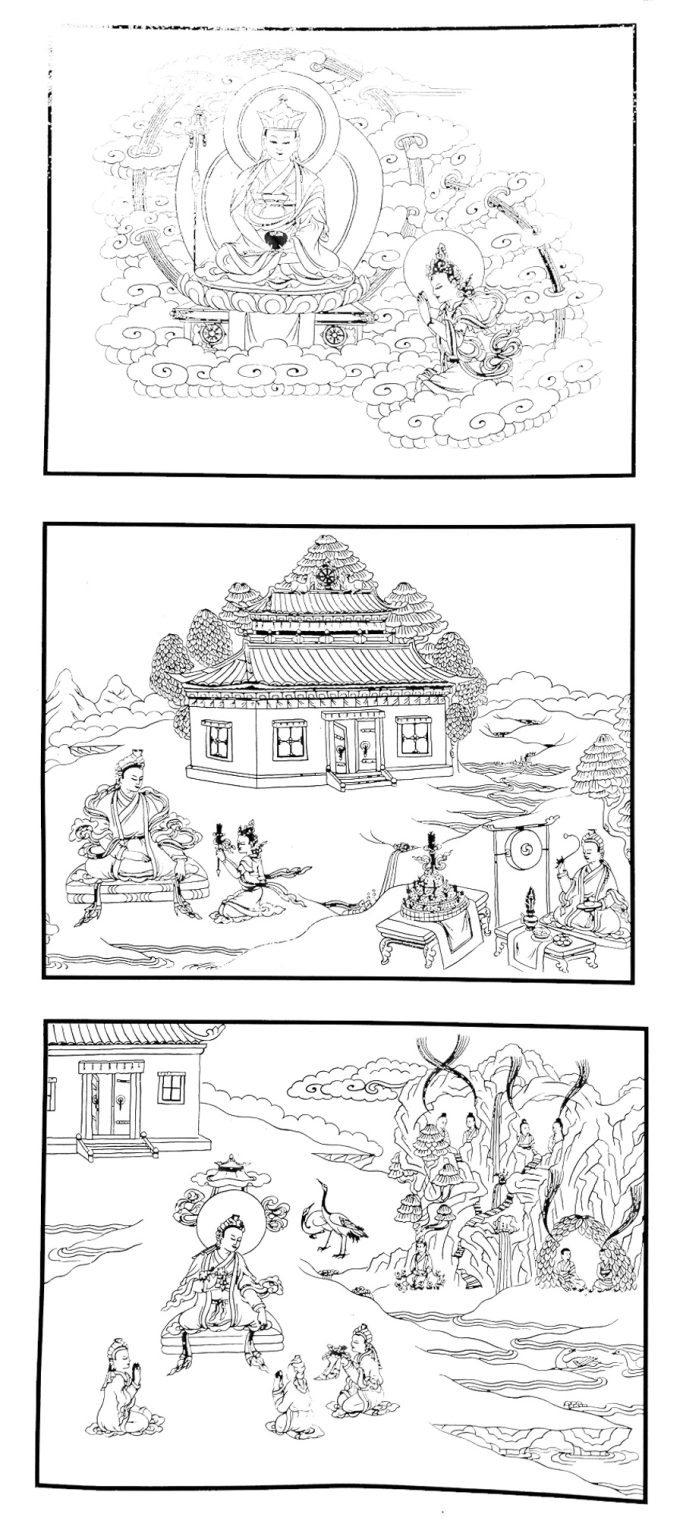
Nyingma Tradition
The Nyingma school of Tibetan Buddhism traces its origin to the Indian adept, Guru Padmasambhava, who came to Tibet in 817 C.E. at the invitation of King Trisong Deutsan (742-797) in order to subdue the evil forces then impeding the spread of Buddhism. Guru Rinpchey, as he is popularly known, bound all evil spirits by oath and transformed them into forces compatible with the spread of Buddhism.

In collaboration with the great Bodhisattva Abbot Shantarakshita, Guru Rinpochey then built Samyey monastery, which became a principal centre of learning and the site where many of the texts that would make up Tibet’s vast Buddhist literature were first translated into Tibetan.
Guru Rinpochey also gave widespread teachings from the highest classes of tantra and in particular to his twenty-five principal disciples. These first Tibetan adepts are renowned for their spiritual accomplishments, for example, Namkhe Nyingpo for his feat of traveling on beams of light, Khandro Yeshe Tsogyal for reviving the dead, Vairochana for his intuition, Nanam Yeshe for soaring in the sky, Kawa Peltseg for reading others’ thought and Jnana Kumara for his miraculous powers.
Contemporary Indian masters Vimalamitra, Buddhaguhya, Shantipa and the tantric adept, Dharamkirti, also came to Tibet and spread tantric teachings. So, although the study of logic and Buddhist philosophy was not yet prevalent, the practice of tantra in extreme secrecy was much favored. Even the work of translating such esoteric texts as Kun-byed rgyal-po, mDo-dgongs-‘dus and the Mahamaya cycle of teachings by Vairochana, Nyag Jnana Kumara, Nubchen Sangye Yeshe and others, was carried out in great secrecy.
Seeing the disciples unripe and the time inappropriate for many of the other teachings he had to reveal, Guru Padmasambhava hid hundreds of Treasures in the forms of scriptures, images and ritual articles, with instructions for their revelation for the benefit of future generations. Subsequently, more than one hundred masters have revealed these Treasures and taught them to their disciples. So, besides the tantric teachings, it is these lineages of revealed teachings combined with the Great Completion or Dzogchen doctrine taught and disseminated successively by Garab Doyjer, Shri Simha, Guru Rinpochey, Jnana Sutra, Vimala Mitra, which are distinguished in Tibet as Nyingma doctrine.
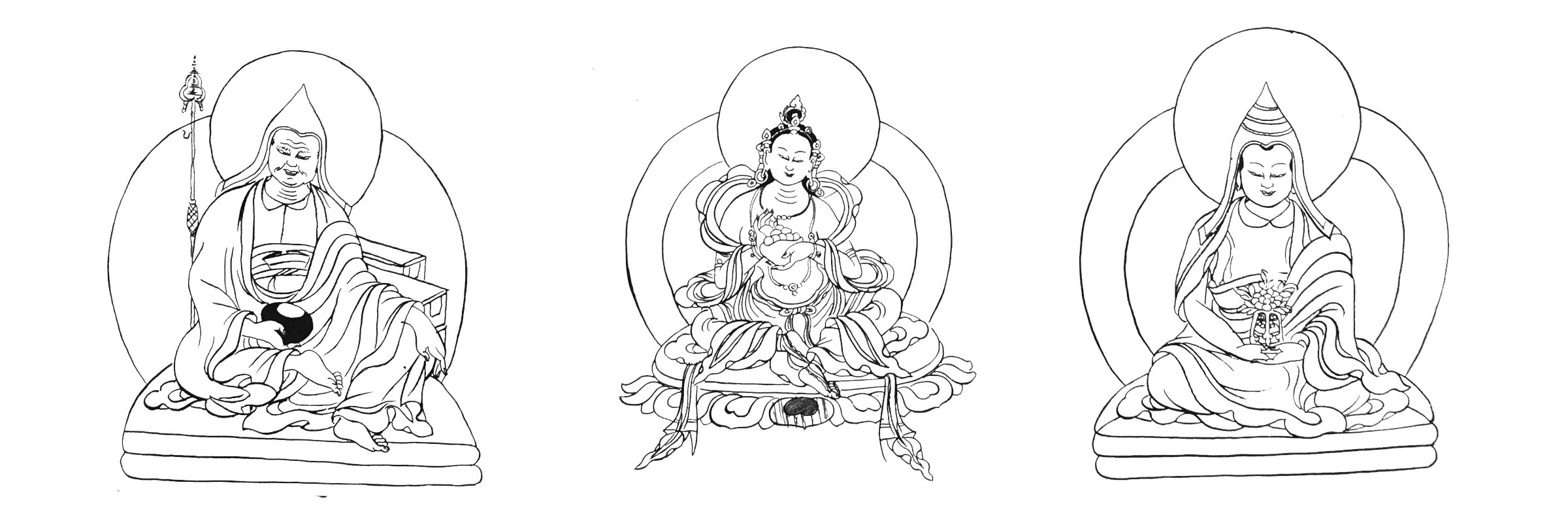
The Nyingma tradition divides the entire Buddhist teaching into Nine Vehicles : the three Common Vehicles comprising the Hearer, Solitary Realizer, and Bodhisattva vehicles dealing with those categories of teachings included in the sutras taught by Buddha Shakyamuni; the Three Outer Tantras consisting of Kriya Tantra which places greater emphasis on practicing proper external behavior, physical and verbal conduct aimed at purification and simple visualization practice; Upa Tantra which lays more emphasis on developing both external and internal faculties with the goal of achieving a deeper affinity with the meditational deity; and Yoga Tantra, which is mainly aimed at developing the strength of inner psychophysical vitality as taught by Vajrasttva. Finally, the Three Innermost Tantras comprising Mahayoga, primarily emphasizing the Generation Stage practice in which the ordinary level of perception and attachment are eliminated through sacred vision and divine pride; the Annuyoga, emphasizing Completion Stage practice in which the vajra body is used as a serviceable means to actualize primordial awareness and the Atiyoga, in which all emphasis is directed towards full activation of the generation and completion stage practices, enabling the yogi to transcend all ordinary time, activity and experience, as taught by Samantabhdra Buddha.
The first six of these nine vehicles are common to all schools of Tibetan Buddhism, whereas the last three, the Innermost Tantras, are exclusive to the Nyingma tradition.
Due to the slightly different approaches of various lineages in presenting Dzoghcen three sub-schools have developed: the Mind School (Sems-sde) is attribute to Shrisimha and Vairochana’s lineage, the Centeredness School (kLong-sde) is attributed to Longde Dorje Zampa, and Shrisimha and Vairochana’s lineage, whereas the Quintessential Instruction School (Man-ngag-sde) is attributed directly to Guru Padmasambhava’s lineage of the Heart’s Drop (sNying-thing) cycle of teaching and practice.
Although Dzogchen is the unique feature of Nyingma practice, even among the lay followers the practice of reciting Guru Rinpochey’s prayers, observing the 10th and 25th of every lunar month as a day for feast offerings, and even retiring into retreat for three years and three months individually or in company are common.
According to the history of the origin of tantras there are three lineages: The Lineage of Buddha’s Intention, which refers to the teachings of the Truth Body originating from the primordial Buddha Samantabhadra, who is said to have taught tantras to an assembly of completely enlightened beings emanated from the Truth Body itself. Therefore, this level of teaching is considered as being completely beyond the reach of ordinary human beings. The Lineage of the Knowledge Holders corresponds to the teachings of the Enjoyment Body originating from Vajrasattva and Vajrapani, whose human lineage begins with Garab Dorje of the Ogyan Dakini land. From him the lineage passed to manjushrimitra, Shrisimha and then to Guru Rinpochey, Jnanasutra, Vimalamitra and Vairochana who disseminated it in Tibet. Lastly, the Human Whispered Lineage corresponds to the teachings of the Emanation Body, originating from the Five Buddha Families. They were passed on to Shrisimha, who transmitted them to Guru Rinpochey, who in giving them to Vimalamitra started the lineage which has continued in Tibet until the present day.
This last mode of transmission is most commonly employed for ordinary people. However, the former two lineages may still exist amongst the highly realized Dzogchen masters.
There is yet another tradition which enumerates six lineages for the origin of the trantras by adding: the Commissioned Instruction Lineage (bK’a-bab lung-bstan-gyi-brgyud-pa), the Treasure Doctrine Lineage of the Fortunate One’s (Las-‘phro gtser-gyi-brgyud-pa) and the Lineage of Trustees Established through Prayers (sMOn-lam gtad-rgya’i-bragyud-pa).
The Nyingma tantric literature and its transmission is classified into three groups: the Oral, Treasures, and Vision. These three may be further subsumed under two categories: the Oral comprising primarily the tantras and associated texts belonging to the cycle of Mahayoga tantras; the root and explanatory tantra belonging to the cycle of Annuyoga tantras; and finally, the Atiyoga or Dzogchen cycle of tantras. The Treasure transmission comprises the innumerable treasure texts revealed by subsequent Treasure Masters, which were hidden by Guru Rinpochey himself in 9th century as well as numerous teaching later revealed through enlightened minds and meditative visions of Nyingma masters. Hundreds of masters have appeared who have revealed treasures. Among them, Nyangral Nyima Ozer (1124-92), Guru Chowang (1212-70), Dorje Lingpa (1346-1405), Padma Lingpa (b. 1405) and Jamyang Khyentse (1820-1892) are renowned as the Five Kings of the Treasure Masters. Their revealed treasures concern, among others, the cycle of teachings and meditations related to Avalokiteshvara, Guru Rinpochey’s sadhanas, the Dzogchen teachings, the Ka-gyey cycle of teachings, the Vajrakila or Phurba cycle of teachings, medicine and prophecies

Hence, in addition to the standard Mahayana Buddhist canon of the Kangyur and Tangyur, many further teachings may be found in the Collection of a Hundred Thousand Nyingma Tantras, compiled in thirteenth century by Terton Ratna Lingpa (1403-1473) and organised by Kunkhyen Longchen Ramjampa (1308-1363). Besides this, numerous works such as the sixty volumes of the Rinchen Terdzod compiled by Kongtrul Yonten Gyatso (1913-1899) and the writings of Rongzom, Dodrupche, Paltrul, Mipham and many others have added to the rich collection of Nyingma literature. The oldest Nyingma institution is Samyey temple completed in 810 C.E by Shantarakshita and Guru Padmasambhava under the patronage of King Trisong Deutsan. Subsequently, no big monasteries were built until the 12th century, when Nechung Monastery was built in central Tibet by Chokpa Jangchub Palden and Kathok Monastery was founded in Kham by Ka Dampa Desheg (1112-92) in 1159. This is an indication that unlike the other Buddhist traditions the Nyingmapas did not become institutionalized until much later in their history. From the 15th century onwards, great monastic universities were built such as Mindroling, founded in 1676 by Rigzin Terdag Lingpa, otherwise known as Minling Terchen Gyurmed Dorje (1646-1714) and Dorje Drag found in 1659 by Rigzin Ngagi Wangpo in central Tibetan; and Palyul established by Rigzin Kunsang Sherab in 1665; Dzogchen built by Dzogchen Pema Rigzin in 1685 and Zhechen established by Zhechen Rabjampa in 1735, all in Kham province. Dodrupchen and Darthang monasteries were established in Amdo.
The Kagyu Tradition
The lineages of the Kagyu school of Tibetan Buddhism derive primarily from two sources: Marpa Chokyi Lodoe (1012-1099) and Khyungpo Nyaljor (978-1079). The former was trained as a translator by Drogmi Yeshe (993-1050), and then traveled three times to India and four times to Nepal in search of religious teachings. He studied at the feet of one hundred and eight spiritual masters and adepts, principally Naropa and Maitripa. Marpa received the lineage of tantric teachings called the Four Commissioned Lineages (bK’a babs-bzhi) – concerning the Illusory Body and Consciousness Transference, Dreams, Clear Light, and Inner Heat directly from Naropa (1016-1100), who had been given them by his teacher Tilopa (988-1069).

Their original source was Buddha Vajradhara. Marpa brought these lineages to Tibet, passing them on to his foremost disciple Milarepa (1040-1123), the most celebrated and accomplished of Tibet’s tantric yogis, who achieved the ultimate goal of enlightenment in one lifetime. Milarepa was given responsibility for his meditation lineage and others such as Ngog Choku Dorjey, Tsurton Wangey and Meton Chenpo became holders of Marpa’s teaching lineage. This is how the dual system of philosophical training (sGub-grva) are found established in Kagyu monasteries. Among Milarepa’s disciples, Gampopa (1084-1161), also known as Dagpo Lhaje and Rechungpa (1084-1161) were the most illustrious. The former received the teaching and practice of the Great Seal (Mahamudra) and the Six Yogas of Naropa from Milarepa and synthesized them into one lineage. The resultant combined lineage came to be known as Dakpo Kagyu, the mother lineage of the Kagyu tradition. Gampopa also pioneered a fusion of Milarepa’s Mahamudra tradition of the Kadama orger. Gampopa’s Jewel Ornament of Liberation is prominent amongst the stages of the path literature of Tibet. The Kgyu Mahamudral lineage was later incorporated into the Gelug tradition by the First Panchen Lama, Lobsang Chokyi Gyeltsen (1570-1662) and is known as the Ganden-Kagyu Tradition of Mahamudra.
The Dakpo Kagyu tradition gave rise to four major schools founded by illustrious disciples of Gampopa. These are the Tselpa (Tshal-pa) Kagyu founded by Zhang Yudakpa Tondu Dakpa (1123-1193), whose chief teacher was Wangom Tsultrim Nyingpo. He founded the Gungthang monastery and had many learned disciples. The Barom (‘Ba-rom) Kagyu was founded by Barom Darma Wangchuk. He built Barom monastery, from which the tradition took its name. The Phagtru (‘Phag-gru) Kagyu was founded by Phagmo Trupa Dorje Gyelpo (1110-1170). He was one of Gampopa’s main disciples particularly noted for his realization and transmission of the Mahamudra teachings. Many of his disciples attained high realization, such as Taglung Thangpa, Kalden Yeshi, Ling Repal Pema Dorjey, Jigten Gonpo and Kher Gompas. Phagmo Trupa also built a monastery in the Phagmo locality which was later called Densa Thil. Many sub-schools grew from his lineage of disciples.

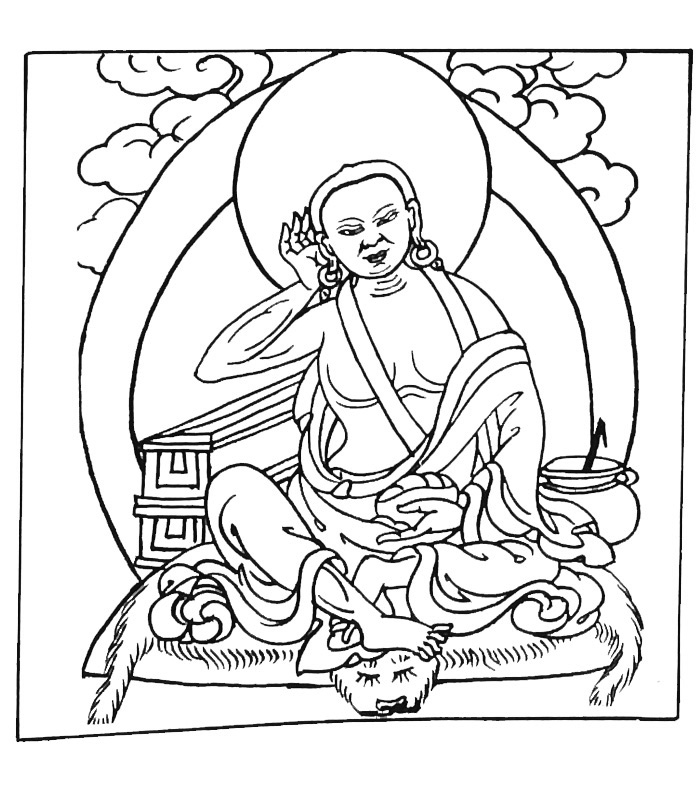
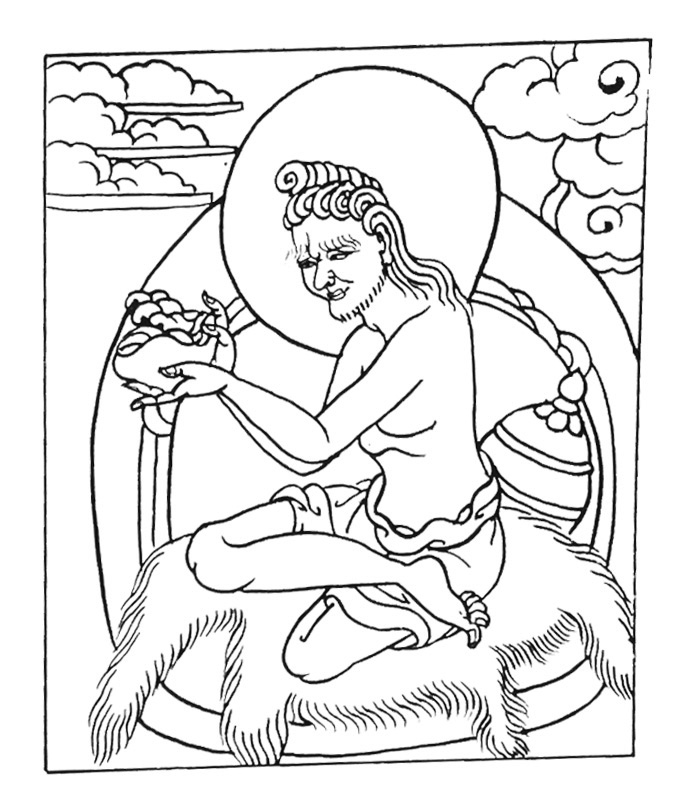

This is the heading
The Kamtsang or Karma Kagyu was founded by the first Karmapa, Dusum Khenpa (1110-1193). This tradition has remained strong and successful due in large part to the presence of an unbroken line of reincarnations of the founder, the successive Karmapas. Famous among them were the Second Karmapa, Pakshi (12.6-1282), the third Karmapa, Ranjung Dorjey (1284-1339) and the Eighth, Karmapa Mikyo Dorjey (1507-1554). The most recent incarnation was the Sixteenth Karmapa, Ranjung Dorje (1924-81), who in exile was also appointed head of the whole Kagyu tradition. In Tibet, Tsurphu, located in Central Tibet was the main monastery of this tradition. After coming into exile, the tradition has re-established its headquarters and pricipal monastic university at Rumtek in Sikkim. It has also developed hundreds of centres throughout the world. In the present absence of the Gyalwa Karmapa's incarnation four high lamas who were his disciples are acting as regents. They are Sharmar Rinpochey and Jamgon Kongtrul Rinpochey.
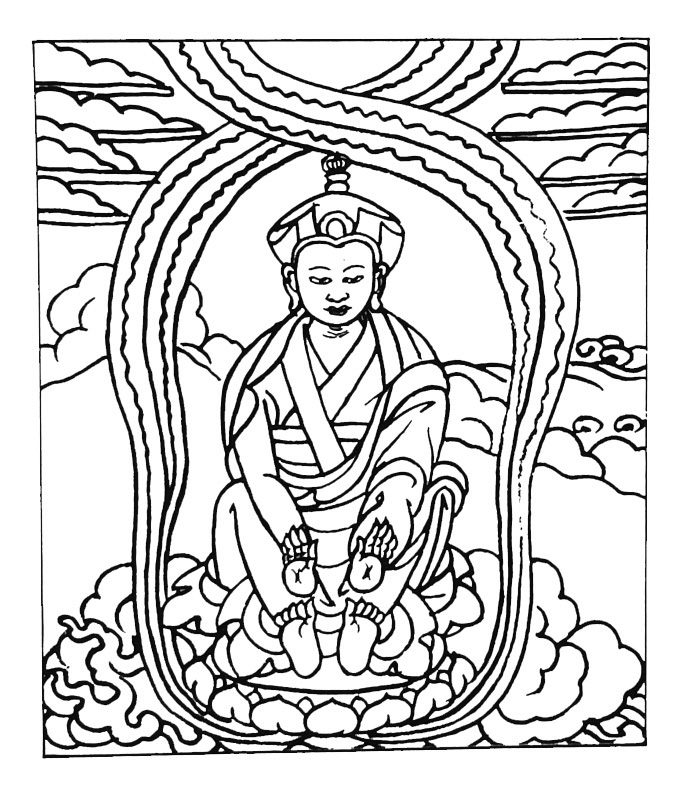
This is the heading
Eight sub-school developed within the PhagduKagyu. The Drikung ('Bri-gung) Kagyu,, founded by Drikung Kyopa Jigten Gonpo (1143-1217) is presently headed by the 37th Successor, Drikung Kyabgon Che-Tsang (b.1 946), who resides at his monastery in Ladakh. The Taglung (sTag-lung) Kagyu, founded by Taglung Thangpa Tashe Phel (1142-1210). The present head of this school is Shabdrung Rinpochey, who now lives in Sikkim. The Drukpa ('Brug pa) Kagyu founded by Choje Gyare Yeshe Dorjey also known as Ling Repa (1128-1189), is headed by the 12th Drukchen Rinpochey, who has re-established his monastery in Darjeeling, India. Among the eight sub-schools only these three survive to the present day, with the Drukpa being numerically the largest, followed by Drikung. Unfortunately other subjects of Kagyu tradition such as Trophu (Khor-phu) founded by Rinpochey Gyaltsa, a nephew of Phagmo Trupa, who built Trophu monastery; Martsang (sMar-tsang) founded by Marpa Rinchen Lodoe; Yelpa (Yel-pa) established by Yepa Yeshe Tsg; the Shungseb (Shungs-gseb) started by Chokyi Sengey and Yamzang (gYa'a-bzang) Kagyu founded by Yeshi Senge have ceased to exist, at least as separate institutions. Although a few lamas of the other major Kagyu traditions may still maintain some of their teaching lineages
The Shangpa Kagyu, one of the two original forms of the Kagyu tradition, was founded by the great adept, Khyungpo Nyaljor (978-1079). Dissatisfied with his training in Bon and Dzogchen practices Khyungpo Nyaljor left for Nepal, where he met Acharya Sumati. From him he received training as a translator and traveled on to India. After having received teaching from one hundred and fifty scholars-adepts he is said to have mastered the entire exoteric and esoteric doctrine as well as meditation on it. His principal teacher includes Sukhasiddha, Rahulagupta and Niguma the consort of Naropa. Besides receiving practical guidance from masters in human form, he also received transmissions from the Dakinis (celestial beings). After returning to Tibet, he received the vows of a monk from the Kadampa master Langri Thangpa.
In accordance with the prophecies of the Dakinis, he established the Shang-Shong monastery at Yeru Shang, in central Tibet. As a result the tradition he founded came to be known as the Shangpa Kagyu. Later he is said to have established further branch monasteries also. In early times, there were more than a hundred monasteries belonging to this tradition in Tibet. Amongst his followers, Mehu Tonpa, Mogchogpa and Shang Gomcho Sengey are some of the most famous. Amongst the later lineages, it was Tsurton Wangi Dorje, from whom Buton Rinchen Drup obtained the lineage of the Guhyasamaja tantra which was subsequently passed down to Tsogkhapa.
The Shanpa Kagyu main practices concerned Mahakala, Chakrasambhava, Hevajra, Mahamay, Guhyasamaja, the Six Doctrines of niguma, Mahamudra, and others. The pricipal contemporary exponent of this tradition was the late Kalu Ronpoche (1905-1989), one of the leading Kagyu meditation masters of this century. It should be noted that while there are many sub-schools.
Kagyupas, the fundamental principles of their doctrine are rooted in Mahamudra and the Six Yogas of Naropa. The different schools have arisen only due to slightly different individual approaches to the fundamental teachings.
Mahmudra, the unique feature of Kagyu tradition, can be explained according to interpretations of sutra and tantra. Both aspects of the teachings are aimed at direct understanding of the real nature of the mind. The approach to Mahamudra, which differs slightly within each Kagyu school, generally follows through the stages of foundation, path and fruit. Tantric practices unique to Kagyu tradition are the Six Yogas of Naropa, Cakrasambhava and Mahakala. In the context of tantric practice, the application of Mahamudra becomes much more profound and sophisticated.
The training of monks in Kagyu monasteries consists mainly of the study of the Perfection of Wisdom, Madhyamika, Valid Cognition, Discipline and Phenomenology common to all traditions, except that each tradition has its own monastic texts and commentaries to facilitate understanding of the original Indian texts.
The Sakya Tradition
The Sakya tradition is closely bound up with the Khon ancestral lineage, which derived from celestial beings. The lineage has descended intact up to the present time from Khon konchok Gyelp (1034-1102), founder of the Sakya tradition.

From the doctrinal point of view the tradition traces its origins to the Indian Yogin Virupa through Gayadhara. His disciple Drogmi Shakya Yeshe (992-1074) traveled to India where he received teachings on the Kalachakra, the Path and its Fruit and others from many Indian masters and returned to Tibet. Later, Khon Konchok Gyelpo, one of his main disciples, built a monastery in the Tsang province of central Tibet and named it Sakya, or Grey Earth monastery. So the school took its name, Sakya, from the location of the monastery. Khon Konchok Gyelpo’s son Sachen Kunga Nyingpo (1902-1158) was a person of extraordinary skill and spiritual attainment, who held all the lineages of tantra and sutra teachings of Arya Nagarjuna and Virupa. He had four sons-Kungabar, Sonam Tsemo, Jetsun Dakpa Gyeltsne and Palchen Opochey. The second son Sonam Tsemo (1142-82) became a learned scholar at the early age of sixteen. He had visions of any meditational deities and also produced many realised disciples. Jetsun Dakpa Gyeltsen (1147-1216) received lay celibacy vows and showed strong signs of spiritual maturity in his youth. At the age of eleven he gave his first Hevajra teachings.
The principal disciple of Jetsun Dakpa Gyeltsen was his nephew, son of Palchen of Opochey the famous Sakya Pandita Kunga Gyeltsen (1182-1251). Sakya Pandita studied Buddhist and no-Buddhist philosophy, logic, Sanskrit, poetry, astrology and art with countless Indian, Nepalese, Kashmiri and Tibetan masters and achieved mastery over them. When he was twenty-seven years old, after meeting with the Kashmiri Pandita Shakya Shribhadra, he became a fully ordained monk and maintained his vows without least infraction. His works such as the Treasury of Logic on Valid Cognition (Tsad-ma rigs-gter) and the Discrimination of the Three Vows (sDom-gsum rab-dbye) are famous even to this day.
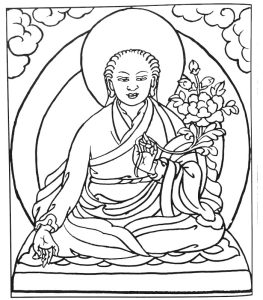
In 1244, Godan Khan, grandson of Chinggis Khan, intrigued by Sakya Pandita’s reputation, invited him to Mongolia, where he gave Buddhist teachings. Later, in 1253, after both Sakya Pandita and Godan Khan had passed away, the emperor, Sechen Kubilai Khan invented a new script in which to write the Mongolian language. Kubilai Khan was so impressed by Phagpa’s performance that he declared Buddhism the state religion of Mongolia and presented him the rule of the three provinces of Tibet. Thus, Phagpa was the first person in Tibetan history to gain religious and secular authority over the whole country. He was succeeded by his brother Chagna and altogether the Sakyapas ruled Tibet for more than a hundred years.
Eventually, Tishri Kunglo (1299-1327), eldest of the fifteen grandsons of Sakya Pandita’s brother, founded four dynastic houses: Zhithog, Rinchen Gang, Lhakhang and Ducho, of which only the last two dynasties have survived. However, in fifteenth century the Ducho dynasty split into two sub-dynasties, or palaces the Dolma Phodrang and Phuntsok Phodrang. The present hierarchs of these two palaces are Sakya Trizin, Ngawang Kunga Teckchen Rinpochey (b.1945), who is the current head of the sakya tradition, and lives in Dehradun, India and, Dagchen Rinpochey (b. 1929), the founder of Sakya Thegchen Choling in the United states of America Succession to the position of head of the Sakya tradition has been hereditary since the time of Khon Konchok Gyelpo and traditionally alternates between the two palaces. Sakya Dagtri Rinpochey, the present incumbent is the 14th occupant of the Sakya Throne.
Amongst the principal holders of the Sakya tradition, Sachen Kunga Nyingpo (1092-1158), Sonam Tsemo (1142-1182), Dakpa Gyeltsen (1182-1251) and Drogon Chogyal Phagpa (1235-1280) are known as the Five Patriarchs of the Sakya tradition. After them, were the so-called Six Ornaments of Tibet: Yaktuk Sangyey Pal and Rongton Mawe Sengey, who were reputed for their authority on sutra teachings; Ngorchen Kunga Zangpo and Zongpa Kunga Namgyel, who were learned in the tantras; Goram Sonam Gengye and Shakya Chogden who were learned in both sutras and tantras. These were famous spiritual masters of Sakya tradition. Amongst them Gorampa Sonam Sengey, instituted the formal study of logic in Sakya tradition.
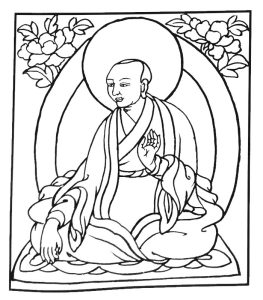
Like other traditions of Tibetan Buddhism, a number of sub-divisions emerged within the main Sakya tradition. The lineage of teachings within the discipline instituted by Ngorchen Kunga Zangpo (1382-1457) and successive masters such as Konchok Lhundrup, Thartse Namkha Pelsang and Drubkhang Pelden Dhondup have come to be known as the Ngor lineage, whereas, the lineages of Tsarchen Losel Gyaltso (1502-56), called the whispered-lineage of Tsar, concerning the Thirteen Golden texts of Tsar, including the secret doctrines of the greater or lesser Mahakala, Vajra Yogini, Jambhala and others, is known as the Tsar tradition. Thus, the Sakya school of the Khon lineage represents the main trunk of a tree, of which the Ngorpa and Tsarpa schools are branches. These are, the three schools (Sa-Ngor-Tsar-gsum) in Sakya tradition.
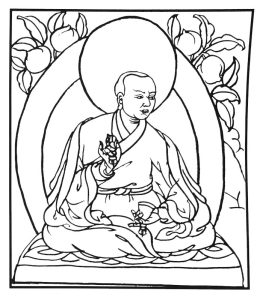
The central teaching and practice of the Sakyapa, called Lamdrey (Lam-‘bras), the Path and Its Fruit is a synthesis of the entire paths and fruits of both the exoteric and esoteric classes of teaching originating from the Indian teachers Virupa, Avadhuti, Gayadhara and Shakyamitra, a follower of Arya Nagarjuna, were brought to Tibet by the Tibetan translator Drogmi and have been passed down through an unbroken lineage of masters until today. During the time Muchen Sempa Chenpo Kunchok Gyeltsen, a disciple of Ngorchen Kunga Zangpo (1382-1457), the Path and Its Fruit transmission broke into two sub-traditions: the Explanation for Private Disciples (sLob-bshad) and for Assemblies (Tshog-bshad) traditions. The philosophical viewpoint expressed in the Path and its Fruit is the inseparability of samsara and nirvana. According to this, an individual cannot attain nirvana or peace by abandoning samsara or cyclic existence, because the mind is the root of both samsara and nirvana. When obscured, it takes the form of samsara and when freed of obstructions it is nirvana. Hence, the reality is that a person must strive through meditation to realize their inseparability.
In the Sakya monastic universities eighteen major texts are thoroughly studies. These deal with the Perfection of Wisdom, Monastic Discipline, Middle path View, Phenomenology, Logic and Epistemology, as well as commentaries unique to the tradition, such as the Discrimination of the Three Vows, the Treasury of Logic on Valid Cognition and the works of Gorampa Sonam Sengey and others. On graduation, a monk is granted the degree of Kazhipa, Kachupa and Rabjampa on the basis of merit. The main tantric practices of the Sakya school are the Hevajra and Chakrasambhara tantras, Mahakala and so forth. The major Sakya monasteries in Tibet were Nalanda in Phenpo built by Rongton Sheja Kunrig, Lhakhang Chenmo, founded by the Khon Konchok Gyelpo, Tsedong Sisum Namgyel, established by Namkha Tashi Gyeltsne and Ngo E-Vam Chodhen, founded by E-Vam Kunga Zangpo in Central Tibet; Dhondup Ling, founded by Dagchen Sherab Gyeltsen and Lhundup Teng founded by Thangtong Gyalpo in Kham; and Deur Chode built by Chodak Sangpo in Amdo.
The Gelug Tradition
The Kadampa tradition founded by Atisha was the direct source of inspiration for the development of the Gelug tradition founded by Je Tsongkhapa (13567-1419). He was born in the Tsonkha region of Amdo province. At the age of three he received full-fledged lay ordination from the Fourth Karmapa, Rolpey Dorje, and the name Kunga Nyingpo. At the age of seven he received novice vows from his teacher, Chojey Dhondup Rinchen, and was given the name Lobsang Drakpa. Even at this young age he had received many teachings and initiations of Heruka, Yamantaka and Hevjra, and could recite by heart texts like Expression of the Names of Manjushri.
Tsongkapa travelled extensively in search of knowledge and studied with masters of all the existing traditions beginning with Chennga Chokyi Gyelpo, from whom he received teachings on topics such as the mind of enlightenment and the Great Seal (Mahamudra). He was taught the medical treatises by Konchok Kyab at Drikhung. In Nyethang Dewachen he studied the Ornament for clear Realization and the Perfection of Wisdom and, excelling in debated, he became famous for his erudition. He also traveled to Sakya where he studied monastic discipline, phenomenology, valid cognition, the Middle Way and Guhyasamaja with lamas such as Kazhipa Losel and Rendawa. He also received transmissions of the Six Doctrines of Naropa, the Kalachakra, Mahamudra, the Path and Its Fruit, Chakrasamvara and numerous others and transmitted them to his disciples.

In addition to his studies and teachings he engaged in extensive meditation retreats. The longest, at Wolkha Cholung, lasted four years during which he was accompanied by eight close disciples. He is reputed to have performed millions of prostrations, mandala offerings and other forms of purification practice. Tsongkhapa frequently had visions of meditational deities and especially of Manjushri, with whom he could communicate to settle his questions about profound aspects of the teachings.
Tsongkhapa studied with more than a hundred teachers, practiced extensively and taught thousands of disciples mainly in the central and eastern regions of Tibet. In addition he wrote a great deal. His collected works, comprising eighteen volumes, contain hundreds of titles relating to all aspects of Buddhist teachings and clarify some of the most difficult topics of sutrayana and mantrayana teachings. Major works among them are: the Great Exposition of the Stages of the Path (Lam-rim chen-mo), The Great Exposition of Tantras (sNgag-rim chen-mo), the Essence of Eloquence on the Interpretive and Definitive Teachings (Drang-nges legs-bshad snying-po), the Praise of Relativity (rTen-‘brel bstod-pa), the Clear Exposition of the Five Stage s of Guhyasamja (gSang-‘dus rim-lngs gsal-sgron) and the Golden Rosary (gSer-phreng). Among his many main disciples, Gyeltsab Dharma Rinchen (1364-1432), Khedrub Geleg Pelsang (1385-1438), Gyalwa Gendun Drup (1391-1474), Jamyang Chojey Tashi Pelden (1379-1449), Jamchen Choejey Shakya Yeshe, Jey Sherab Sengey and Kunga Dhondup (1354-1435) are some of the more significant.
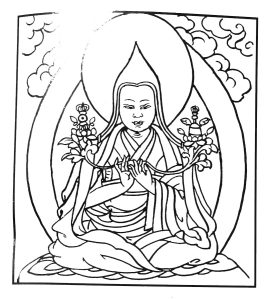
Tsongkhapa finally passed away at the age of sixty on the twenty-fifth of the tenth Tibetan month, entrusting his throne in Ganden to Gyeltsabjey. So began a tradition which continues to the present day. The ninety-ninth successor to the Ganden throne, and thus the formal head of the Gelugpa, is Ven. Yeshi Dhondup.
Of the major Gelugpa monasteries in Tibet, Ganden Monastery was founded by Tsonkhapa himself in 1409 and was divided into two colleges, Shartsey and Jangtsey. Jamyang hoeje Tashi Pelden founded Drepung Monastery in 1416. At one time it had seven branches but these were later amalgamated into four-Loseling, Gomang, Deyang and Ngagpa. Of these, only two colleges, Drepung and Gomang have survived up to the present time. Another of Tsongkhapa’s spiritual sons, Jamchen Chojey Shakya Yeshi established Sera Monastery in 1419. This too initially had five colleges which were later amalgamated into two-Sera-Jey and Sera-Mey. Similarly, Gyalwa Gendun Drup, the First Dalai Lama, founded Tashi Lhunpo Monastery at Shigatse in 1447, which was to become the seat of the successive Panchen Lamas. It originally had four colleges.
The Lower Tantric Colleges, Gyurmey, was established by Jey-Sherab Sengey in 1440, and the Upper Tantric College Gyuto by Gyuchen Kunga Dhondup in 1474. At their peak there were more than five thousand monks in each of the monastic universities around Lhasa, Ganden, Drepung and Sera, while here were at least five hundred in each tantric college. Young men would travel from all three regions of Tibet to enroll at these monastic universities as monks in order to receive an education and spiritual training. The Gelug tradition lays special emphasis on the place of ethics, as expressed through monastic discipline, as the ideal basis for religious education and practice. Consequently, the great majority of Gelugpa lamas are monks and the master who is a layman is a rarity. In addition, the Gelug tradition regards sound scholarship as a prerequisite for constructive meditation, hence, the teachings of both sutra and tantra are subject to rigorous analysis through the medium of dialectical debated.
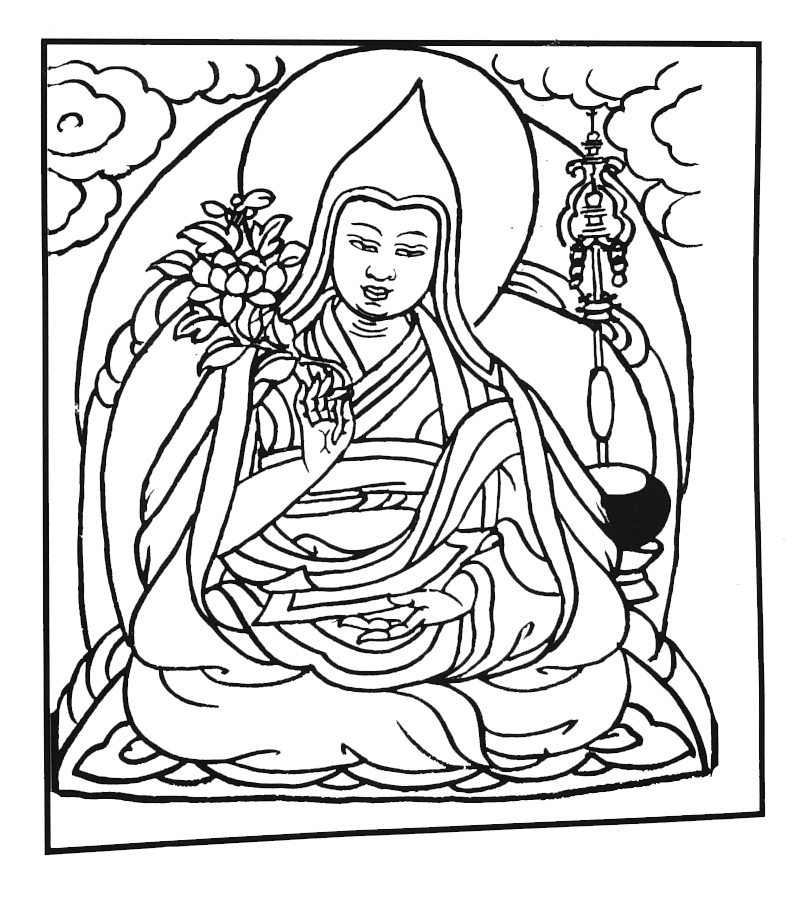
In general, the curriculum of study covers the five major topics-the perfection of wisdom, philosophy of the Middle way, valid cognition, phenomenology and monastic discipline. These five are studied meticulously by the dialectical method using Indian texts as well as Indian and Tibetan commentaries to them, often textbooks unique to each monastic tradition, for a period of fifteen to twenty years. On completing this training, a monk is awarded one of three level of the degree of Geshey (Doctorate of Buddhist Philosophy), Dorampa, Tsogrampa and Lharampa, of which the highest is the Geshey Lharampa degree.
Subsequently, if he so wishes the Geshey may join one of the tantric colleges to study the tantras and so complete his formal studies, or he may return to his local monastery to teach, or retire into seclusion to engage in intensive meditation. A monk who has completed a Geshey’s training is respected as being a fully qualified and authoritative spiritual master worthy of devotion and esteem.
Contact Us
- Da Lama Kh.Byambajav, Secretary General of ABCP, Gandantegchenling Monastery, Ulaanbaatar-38, Mongolia 16040
- abcphqrs@gmail.com
- +976 11 360069, +976 99117415
- Mr. Burenbayar Chanrav, Senior Manager, ABCP, Gandantegchenling Monastery, Ulaanbaatar-38, Mongolia 16040
- cburenbayar@gmail.com
- +976-99101871
Newsletter
You can trust us. we only send promo offers,
